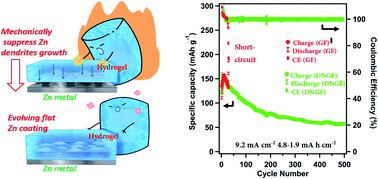High strength hydrogels enable dendrite-free Zn metal anodes and high-capacity Zn–MnO2 batteries via a modified mechanical suppression effect†
Abstract
Rechargeable aqueous zinc-ion batteries (RAZIBs) have some inherent advantages such as intrinsic safety, low-cost and theoretically high energy density, making them a current topic of interest. However, the phenomenon of zinc (Zn) dendrite growth at the anode results in the instability of RAZIBs and limits their real-world application. Herein, by employing a high strength hydrogel polymer electrolyte, the growth of dendritic Zn crystals is effectively eliminated through the mechanical suppression effect, resulting in a stable Zn anode that demonstrates dendrite-free plating/stripping with a long lifespan. Even under a high current density of 5 mA cm−2, the Zn‖Zn symmetric cell is shown to have a cyclic lifetime of longer than 1000 hours. Moreover, the stable cyclic performance of the Zn anode spawns a Zn‖MnO2 battery with high capacity (4.8–1.9 mA h cm−2) and long lifetime (500 cycles at 9.2 mA cm−2, 1C), which can meet the practical demands for portable devices. This work shows that high strength polymer gel electrolytes with internal energy dissipation mechanisms can overcome previous challenges that prevented practical utilization of RAZIBs. Together with the outstanding cyclic properties of the high capacity Zn‖MnO2 batteries, this work provides a new pathway toward designing high energy density RAZIBs.



 Please wait while we load your content...
Please wait while we load your content...